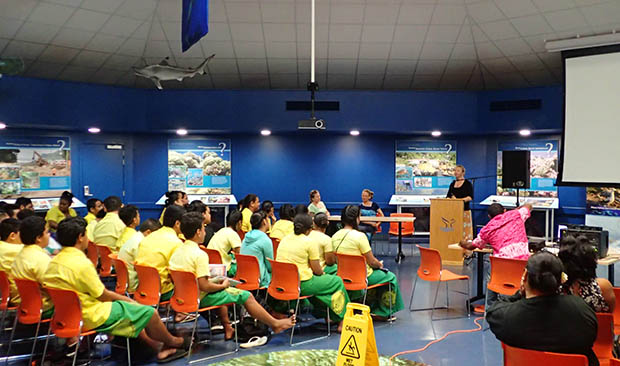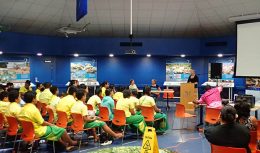

In 1917, Alfred Mayor from the Carnegie Institute began what is now the world’s oldest continuously monitored coral reef transect in the world. The Aua transect on Tutuila island in the remote island territory of American Samoa celebrated its 100th anniversary, and scientists from throughout the region traveled to the island for a week-long celebration and to conduct the 100th year transect survey.
Kelley Anderson Tagarino, an extension agent from the University of Hawaiʻi Sea Grant College Program who is based at American Samoa Community College (ASCC), partnered with colleagues from the National Marine Sanctuary of American Samoa and the American Samoa Coral Reef Advisory Group to organize the activities surrounding this important milestone. During the celebration she led outreach events in Aua village where students from ASCC taught local youth about the importance of coral reefs, and provided hands-on training in coral survey methods.
Education and outreach for American Samoan reefs
Throughout the week students from ASCC, as well as middle and high school students, had the opportunity to interact with the visiting scientists and participate in hands-on activities. The week-long celebration ended with a coral reef symposium attended by more than 60 middle and high school students who learned that American Samoa reefs are world renowned for their resiliency, and the long-term monitoring that had occurred continually since 1917 was unique to their island. The students were so inspired by these events that they offered to assist in the annual transect surveys in the future. They were shown the importance of ensuring that this invaluable resource continues to be monitored for decades to come and were made to realize that this is their heritage.
Charles Birkeland, UH Mānoa professor emeritus and Alison Green from the Australian Research Council Centre of Excellence for Coral Reef Studies in Australia, two visiting scientists who had previously surveyed the area, flew in to re-survey the transect and document the overall coral cover. Birkeland noted “I was delighted to be part of the 100th year transect survey and was gratified to see such support from the Aua village council and local agencies. The enthusiastic interest of the local students is something American Samoa should be proud of. I can honestly say that I have never experienced such a reception and interest in science and their marine heritage.”
Coral loss and recovery
While the overall coral cover had declined since Alfred Mayor’s original survey was completed in 1917, much of the coral loss was attributed to the blasting of large portions of Pago Pago harbor for shipping channels and dredge and fill operations which is now prohibited by increased environmental regulations. In addition, new laws were put in place in the 1990’s requiring the tuna canneries to pipe discharge further from the mouth of the harbor. Once this regulation was implemented the effluent from the canneries dissipated, the harm to the reefs was substantially minimized, and the corals had the opportunity to rebound.
Future surveys will be coordinated by the American Samoa Coral Reef Advisory Group and Hawaiʻi Sea Grant with support from the ASCC Marine Science Program. For more information please email Kelley Anderson Tagarino, or call 1 (684) 699-3353 or 1 (684) 258-2967.
Read more about the celebrations at Samoa News.
—By Cindy Knapman




